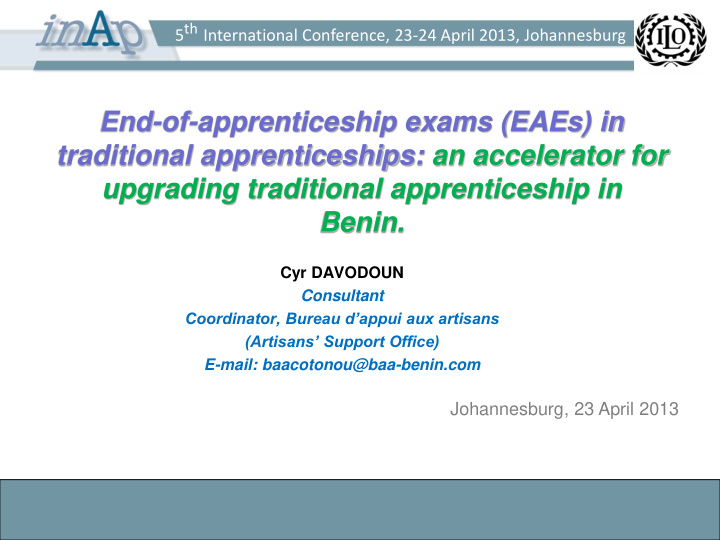



5 th International Conference, 23-24 April 2013, Johannesburg End-of-apprenticeship exams (EAEs) in traditional apprenticeships: an accelerator for upgrading traditional apprenticeship in Benin. Cyr DAVODOUN Consultant Coordinator, Bureau d’appui aux artisans (Artisans’ Support Office) E-mail: baacotonou@baa-benin.com Johannesburg, 23 April 2013
5 th International Conference, 23-24 April 2013, Johannesburg Session plan 1 - General information on EAEs 2 - Implementation strategy 3 - Participants and their roles 4 - Institutional and organisational composition 5 - Activities relating to EAEs 6 - Quantitative outputs obtained 7 - Changes effected - harmonization of practices 8 - Changes effected - ending certain practices 9 - Changes effected - establishing good practices in apprenticeship 10 - Other changes effected at actor, commune and national level
5 th International Conference, 23-24 April 2013, Johannesburg General information on EAEs Process of evaluating the skills acquired by apprentice artisans at end of their apprenticeship, to be organized, managed and funded independently by local actors (local authorities, artisan collectives etc.) In 29 communes situated in 5 local authorities in Where do Benin What are they take they? place? Swiss Support Programme for Artisans (ASAA) Contribute to Through what Inter-commune strengthening human programmes? EAE Programme to Support capital at local level To what Apprenticeship (PIC2A) through the purpose? vocationalization and qualification of the Financial partners: Swiss and local workforce Who are these Danish cooperation efforts partners? Technical partner: Artisan Support Office
5 th International Conference, 23-24 April 2013, Johannesburg 2-Implementation strategy All public and Informatio Information/ private local n/Sensibili awareness Organization actors raising sation of EAEs Creation of EAE managing Institution Opération Beginning Creation of orate bodies nalisation operations institutions nalisation through commune- level legal orders Members of management Formation Training bodies
5 th International Conference, 23-24 April 2013, Johannesburg 3-Participants and their roles Actors Roles or missions - Play a major role in organizing EAEs - Organize the General Assembly to launch the EAE process Receive candidates’ entries - Artisan collectives - Have the major role in running EAE managing bodies - Collect exam fees on behalf of the organizing committee - Set framework conditions (order for official establishment of the exams, order to create EAE managing bodies, order to nominate the artisanal sector focal point) - Take part in the running of the commune consultative council Local authority - Sign the list of candidates admitted Artisans’ association - Contribute to the smooth running of the process of organizing EAEs - Inform affiliated and non-affiliated members of the same corporation Association of apprentices’ - Take part in the EAE organizing bodies Raise awareness among apprentices’ parents and tutors to enable them to play their part well - parents - Contribute to improving apprenticeship - Train apprentices Employers - Set tests - Sit on juries - Facilitate collaboration between the local authority and artisans Artisan sector focal point - Take part in the running of EAE managing bodies Provide technical support to the collective of artisans’ associations - Development association - Take part in the work of the commune consultative council - Be involved in raising public awareness
5 th International Conference, 23-24 April 2013, Johannesburg 4-Institutional and organizational composition Commune Piloting consultative council Preparation General Organizing assembly committee Implement- ation Launching body Artisans’ collective Consultation Monitoring commission Exam centres Exam Jury 3: Jury 1: Jury 2: Evaluation Deliberations Correction
5 th International Conference, 23-24 April 2013, Johannesburg 5-Activities relating to EAEs Start Register candidates E1 E2 Publish lists Phase 1 E3 Appoint juries E4 Preparation Prepare tests E5 Identify exam centres E6 Issuing certificates E7 Allocate candidates and jurys Phase 7 E8 Prepare tutors and materials E9 Draw up budget Holding exams Drawing up report Phase 6 E10 Appoint secretariat Phase 2 Organization of appeals E2 Deliver and run tests Phase 5 E3 Monitor knowledge Correction Phase 3 Deliberation Centralize data Phase 4 E1 E2 Anonymize data E3 Organize the work of the juries E4 Mark and grade the tests
5 th International Conference, 23-24 April 2013, Johannesburg 6-Quantitative outputs obtained 4500 4000 3892 3599 3500 3000 2500 2149 Registered Inscrits Admitted Admis 2000 1941 1538 1500 1432 902 1000 883 500 0 2008 2009 2010 2011
5 th International Conference, 23-24 April 2013, Johannesburg 7-Changes effected – Harmonization of practices APPRENTICESHIP LENGTH FRAIS D’APPRENTISSAGE APPRENTICESHIP FEES HARMONIZATION UNIQUE EVALUATION CERTIFICATE CRITERIA FORMAT
5 th International Conference, 23-24 April 2013, Johannesburg 8-Changes effected – practices ended GRADUATION “DOWRY” RUINOUSLY EXPENSIVE GRADUATION CEREMONIES TIME OFF WORK TO GRADUATE ENDED LEGAL REGISTRATION OF THE “FINAL CANING” RITUAL ORIGINAL CERTIFICATS
5 th International Conference, 23-24 April 2013, Johannesburg 9-Changes effected – good practices established APPRENTICESHIP CONTRACT REGISTER OF THE APPRENTICE’S CARD ESTABLISHMENT APPRENTICES MANAGEMENT OF ENTRANT AND LEAVER FLOWS
5 th International Conference, 23-24 April 2013, Johannesburg 10-CHANGES EFFECTED - OTHER O BETTER TRANSFER OF SKILLS BY EMPLOYERS T H INCREASED AWARENESS AMONG APPRENTICES AND EMPLOYERS E R CERTIFICATES ACKNOWLEDGED BY LOCAL AUTHORITIES O U T A DYNAMIC OF INTER-COMMUNE WORKING C O M INCREASED CONTRIBUTIONS FROM ARTISANS TO THE PUBLIC COFFERS E S ROLLOUT OF THE PROGRAMME THROUGH CQM
5 th International Conference, 23-24 April 2013, Johannesburg THANK YOU FOR YOUR KIND ATTENTION
Recommend
More recommend